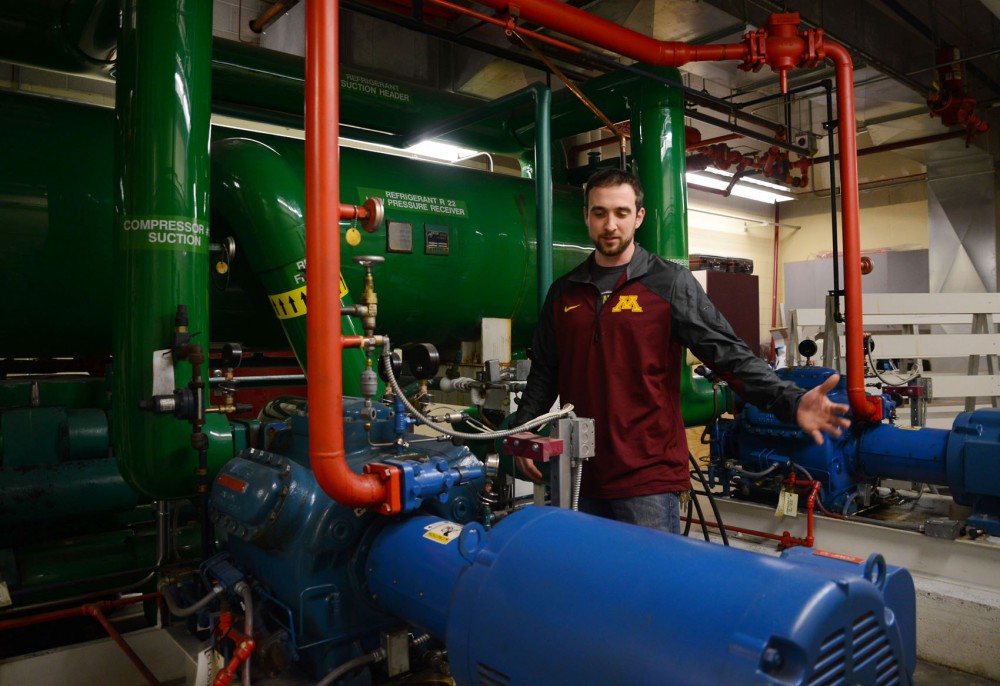University of Minnesota Athletics paid $20,000 earlier this month to repair a leaky pipe in the cooling system beneath Mariucci Arena’s ice. But if the same leak happened in the 1990s, officials say they might have only had to pay about $1,000.
The facilities staff had to replace the systems coolant, R-22 — the same refrigerant used to cool most of the more than 160 official ice rinks throughout Minnesota — after it leaked out of the pipes.
Because the chemical creates pollutants that deplete the Earth’s protective ozone layer, the United States Environmental Protection Agency began an initiative to phase out its production and import by 2020, which has made the chemical increasingly expensive since the early 2000s. Some hockey enthusiasts throughout Minnesota are now worried the financial burden to transition will be too much for some rinks to bear.
“It’s been a hot topic for the past couple years,” said Craig Flor, facilities director for the University’s hockey arenas.
Ice rink refrigeration is a closed circuit, he said, so the same R-22 can be used to cool an arena for years. But many of Minnesota’s ice arenas are nearing 50 years old, so pipe leaks happen often.
Some have recommended that the Mariucci and Ridder arenas use an alternative coolant, like ammonia, Flor said, which would be less expensive to replace during leaks and more energy efficient in the long run. But demolishing the arenas’ concrete floors to replace the cooling system would cost millions of dollars, he said, so the athletics department would probably need to fundraise or take out a loan.
Though R-22, sometimes called Freon, is an issue within University sports facilities, many people don’t know anything about it.
“A lot of people are kind of naive about it in their own communities,” said John Hamre, former hockey coach and University alumnus.
Hamre recently wrote a series of articles for Minnesota-based newspaper Let’s Play Hockey about how R-22 is affecting arenas in greater Minnesota.
Without enough revenue from taxes or rentals, he said, some ice arenas in small towns are having an even harder time paying for the maintenance on their cooling systems since the EPA standard has caused R-22 prices to rise.
“If there’s no help, it might be totally out of the realm of being affordable,” Hamre said, “and then you risk some of these rinks shutting down because these communities can’t afford to do the right thing — to change out the Freon system.”
And many ice arenas already have other financial problems, he said.
The Minnesota State Fair’s Warner Coliseum ice rink closed in 2013 because of dwindling rink rentals and deteriorating ice-making equipment, according to the fair’s marketing and communications manager, Brienna Schuette.
And another aging ice arena in Baudette, Minn., may be forced to close if maintenance from leaky pipes becomes too costly, Hamre said.
Because many ice arenas are financed like public parks, he said, their revenue usually only allows them to break even on their budget, which doesn’t leave leftover money for maintenance or system changes.
“When the infrastructure gets old, there’s not even a bit of surplus of funds that they can set aside to make these improvements,” said John Evans, a former hockey player and member of the Minnesota Amateur Sports Commission.
Evans said the state should help old arenas, especially ones in small communities, through the coolant transition.
Last legislative session, he played a role in persuading the Legislature to appropriate $1.5 million to hockey arenas throughout the state in grants. About one-third of that money went to arenas that were changing the use of R-22 in their facilities, Evans said, with the rest going toward maintenance costs and helping arenas afford electric
Zambonis, as traditional fuel types can emit air pollutants.
“Last [legislative] session, if you said R-22, [lawmakers] said, ‘No, I’m 52.’ People had no idea what it meant,” Evans said. “This session, most everyone knows what you’re talking about.”
This year, a Senate bill with bipartisan support is asking for another $5 million to help the arenas.
Hockey is an important part of the state’s culture, Evans said, so he thinks its funding should be a priority. And many of the state’s senators, as well as Gov. Mark Dayton, played collegiate and professional hockey.
Evans said he’s seen the transition away from R-22 pay off for some communities.
New Hope was able to save a lot of money in energy costs after replacing R-22 with a new refrigerant and installing LED lighting in its arena, he said.
“To be able to make a rink green, efficient and keep it viable in greater Minnesota is a great deal,” Evans said.








